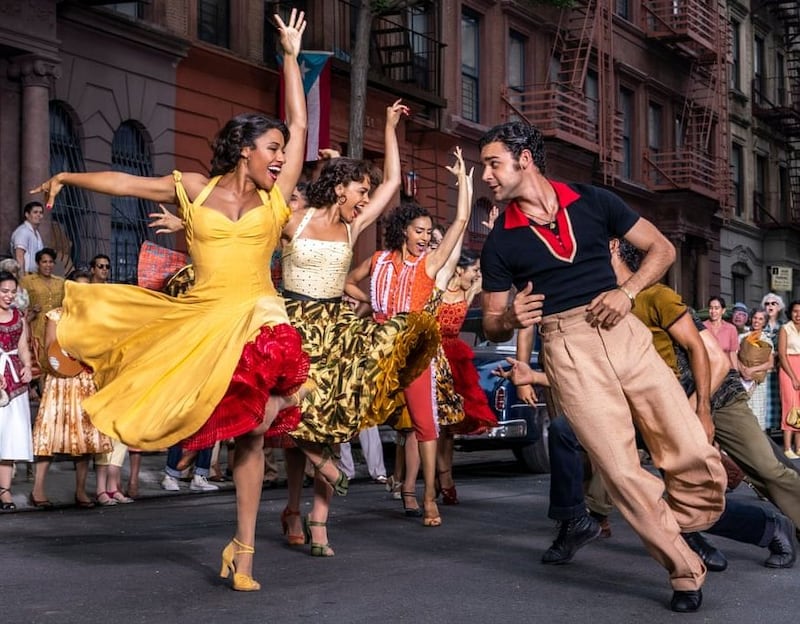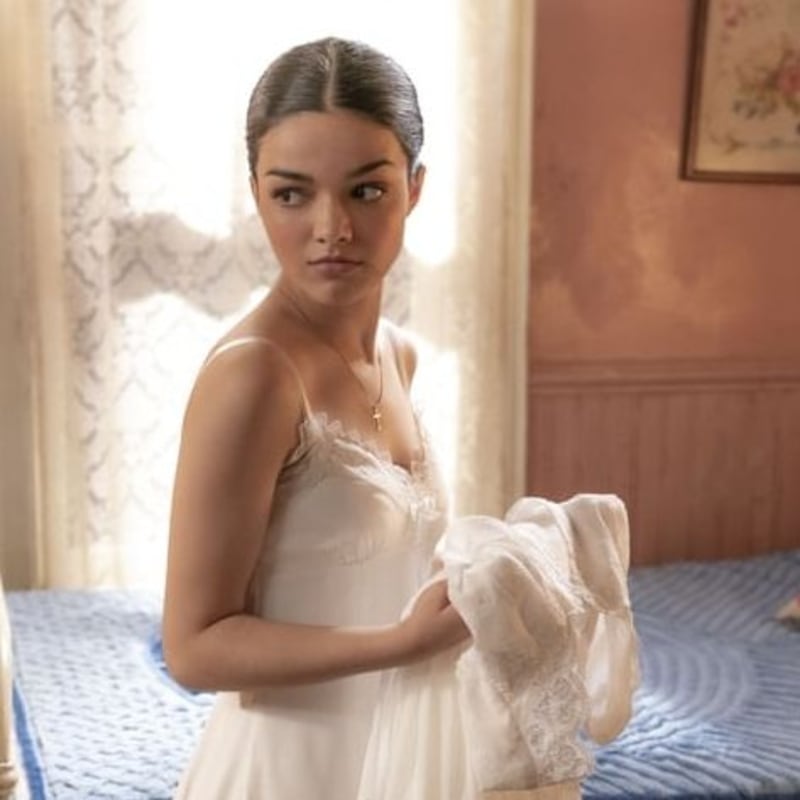It’s a winter afternoon and you’re about to begin a video call with Steven Spielberg. The perfect opportunity, then, to make a quick brew in your Gremlins mug (Spielberg produced that devilish 1984 horror-comedy), then brandish it in front of the webcam for the director’s benefit. “Oh, I love that, thank you,” he says, chuckling softly. Then he wags a cautionary finger: “Don’t drink it after midnight!”
The most famous and widely cherished film-maker in history is all twinkling eyes and gee-whiz charm today. He is about to turn 75, but first there is the release of his muscular new take on West Side Story, which marks his third collaboration with the playwright Tony Kushner, who also scripted Munich and Lincoln. Spielberg is at pains to point out that this not a remake of the Oscar-laden movie but a reimagining of the original stage musical. “I never would have dared go near it had it only been a film,” he says. “But, because it’s constantly being performed across the globe, I didn’t feel I was claim-jumping on my friend Robert Wise’s 1961 movie.”
Spielberg and West Side Story go back further than that. He was 10 when he became obsessed with the Broadway cast album, which his father brought home in 1957. He even got in trouble for belting out the show’s comedy number Gee, Officer Krupke. “With my dad right across from me and my mother next to me, I sang, ‘My father is a bastard / My ma’s an SOB… ’ Oh my God, they got so mad. ‘You can’t say “bastard” at the dinner table! Where did you learn that?’ I said, ‘It’s on your record!’”
Fear is my fuel and confidence is my enemy. If I'm on my heels I get better ideas than, let's say, coming in to do the sequel to Jurassic Park. It's a lot better for me not to make the sequel to Jurassic Park
It was Jerome Robbins who had the idea of transposing Romeo and Juliet to New York’s Upper West Side. Leonard Bernstein provided the score, Arthur Laurents the script and a young greenhorn named Stephen Sondheim the lyrics. Tony and Maria, played in Spielberg’s version by Ansel Elgort and Rachel Zegler, were the star-cross’d lovers, while two warring gangs, the Jets and the Sharks, stood in for the Montagues and Capulets.
Which gang did the young film-maker run with during his adolescence in Arizona and California? “Me in a gang?” he splutters. “Yeah, right! No, I was in the Boy Scouts of America. And a movie club. My friends and I made movies on 8mm when we were 12 or 13 so I was just part of that nerdy, geeky little club.”
He did, however, come to be known in the 1970s as one of the Movie Brats, so-called because they were the first generation of US film-makers to have absorbed much of their education from the screen, and went on to electrify and transform Hollywood. Of that quintet – Francis Ford Coppola, Brian De Palma, George Lucas and Martin Scorsese were the others – Spielberg was the only one who hadn’t made a leap into musicals.
“Francis did it with Finian’s Rainbow, Brian with Phantom of the Paradise, Marty with New York, New York. I do think you have to consider American Graffiti to be George’s musical. Which means all the Movie Brats have done it now, and I was the last. I’m proud to be the caboose.”
He had some healthy anxiety beforehand. “I work better that way,” he explains. “Fear is my fuel and confidence is my enemy. If I’m on my heels I get better ideas than, let’s say, coming in to do the sequel to Jurassic Park. It’s a lot better for me not to make the sequel to Jurassic Park.”

Musical numbers, such as the dance contest in Spielberg’s wartime comedy 1941 or the dazzling Busby Berkeley homage at the start of Indiana Jones and the Temple of Doom, have cropped up in his films without him ever quite putting more than a toe in the water – or rather, on to the dancefloor. His 1991 fantasy Hook, starring Robin Williams as a grown-up Peter Pan, even began life as a musical.
“I chickened out after the first week of shooting and took all the songs out,” he says. “It was the biggest paradigm shift I’ve ever had while directing a movie. It just didn’t seem right for some strange reason. Maybe I didn’t feel ready to do a musical. I was okay doing those little numbers in 1941 or Temple of Doom, and later there was a kind of zero-gravity dance to the Bee Gees in Ready Player One. I had a couple of false starts, too, with scripts that I began developing into original musicals. At some point I decided I had to have the courage of my convictions.”
That meant returning to the musical that had earned him a scolding at the dinner table. “It has never left my life,” he says. “I’ve played the cast album to my kids. They memorised the songs growing up. I’ve got videos where I’m running around the place playing Officer Krupke and all the Jets. Those videos prove how West Side Story has permeated my entire life and the lives of my kids and grandkids. It’s crazy!” Is he much of a dancer? “I’m a good faller,” he says with a smile. “I have a number of left feet. I’ve been tripping over cables on my own sets since I was a television director at 22. It’s harder now at almost 75. You don’t want to be doing that as much.”
The majority of young people don't know what West Side Story is. This will be their introduction
His feelings for West Side Story are indisputable, but love alone is not reason enough to make a new version of existing material. That much was proved by the negative reaction to Always, his 1989 update of Victor Fleming’s 1943 romantic fantasy A Guy Named Joe. “It was a great love story that really touched me, and I’d never made a love story before,” he says. “I used to show the 1943 film to girlfriends when I was dating, and if they didn’t like it I wouldn’t go out with them again. The two that were litmus tests for whether there was going to be another date was A Guy Named Joe and Stanley Donen’s Two for the Road. If they didn’t like those films, that was it!”
Fortunately, his West Side Story has urgency as well as affection behind it, introducing a racial and socioeconomic specificity that earlier versions were poorly placed to provide. “What isn’t in the play or the 1961 movie is San Juan Hill being razed by the wrecking ball,” he says, referring to the redevelopment that demolished entire blocks in Manhattan, predominantly displacing low-income families of colour.
As Zegler tells me later: “Tony’s script brings out the realities of what it was like for those communities. Lieutenant Schrank says it in the first scene, ‘You’re in the way.’” Several dance numbers now take place among torn metal and piles of rubble, or on splintered piers. “The Jets climb to the top of a rubbish heap,” Spielberg says. “It’s, like, ‘That’s what they’re fighting for?’”
There is also a new weight and dignity afforded West Side Story’s Latinx characters, whose culture – and the racism they face – is more sharply drawn. When I speak to Ariana DeBose, who plays Maria’s friend Anita, she confesses to mixed feelings about the 1961 film. “It’s a product of its time,” she says. “You realise, ‘Oh, they’re in brown-face.’ That is not my favourite thing about the film. But I do still think it’s a classic.”
She made it clear when she auditioned for Spielberg and Kushner that her ethnicity would need to be addressed if she were hired. “I said to them, ‘If you’re not interested in exploring the fact that I am Afro-Latina, that I am a black woman, then I don’t think you should consider me.’ And they were very much not afraid of that. My presence in this film is not stunt casting. It has allowed us to start a conversation around colourism and how it affects Latinx culture.”

Young audiences who may never have heard of West Side Story, let alone the shortcomings of any previous version, would expect nothing less. It is for them that the new film primarily exists. “The majority of young people don’t know what West Side Story is,” says Spielberg. “This will be their introduction.” He also made it for – and dedicated it to – his father, who died last year aged 103. “I didn’t have it finished in time for him to see it. But while I was on set in New York, my assistant was running around with FaceTime on the iPad, and my dad would be sitting at home in LA watching us shoot a lot of the movie, so he felt part of our company.”
Another absent figure is Sondheim, who died last month at 91. On set he was known as SS1, while Spielberg was SS2, a ranking stipulated by the film-maker. They had known each other since the mid-1980s. As well as being present for some of the filming, which was completed before the pandemic, the composer attended every recording session.
“Then, during Covid, I discovered he was as much of a cineaste as Scorsese or myself, and that he had seen the most obscure movies. So we began this tremendous back-and-forth on email for almost 18 months and he became a very good friend. We would recommend films to each other, then we’d watch them and get on the phone or email about them.”
Did Sondheim pass the Guy Named Joe/Two for the Road test? "No, he didn't," he says, laughing. "He didn't like either of those movies at all." Alas, no second date. Just a beautiful friendship.
West Side Story is on general release



















